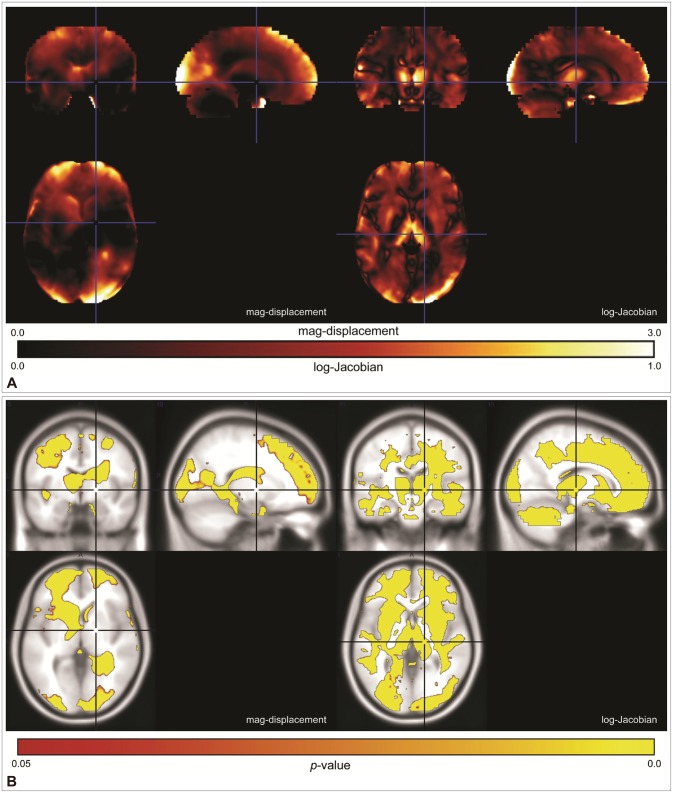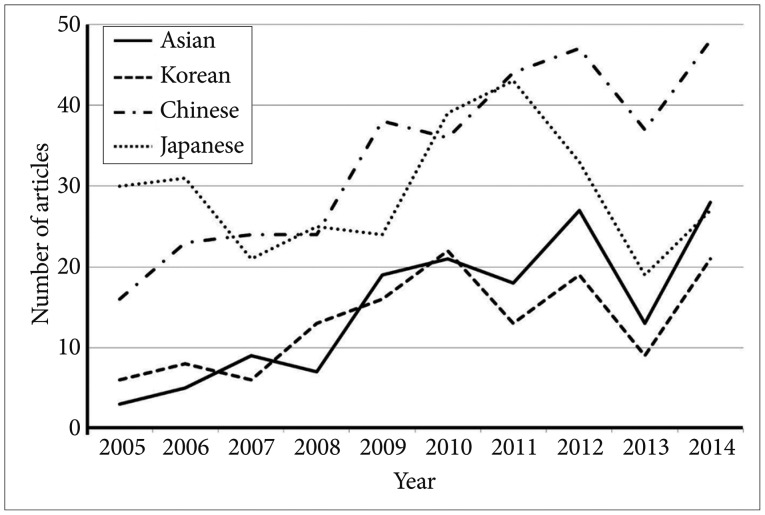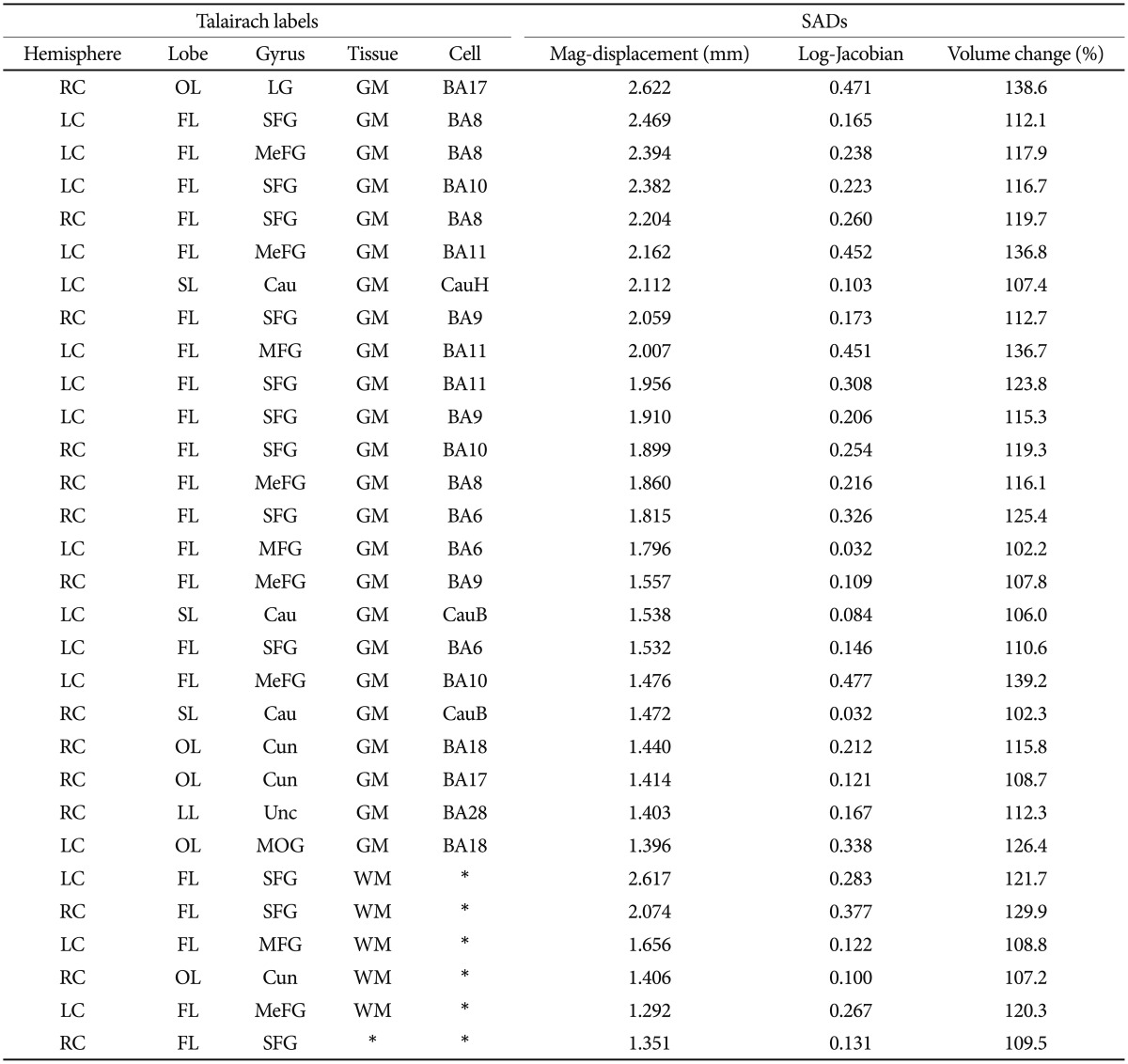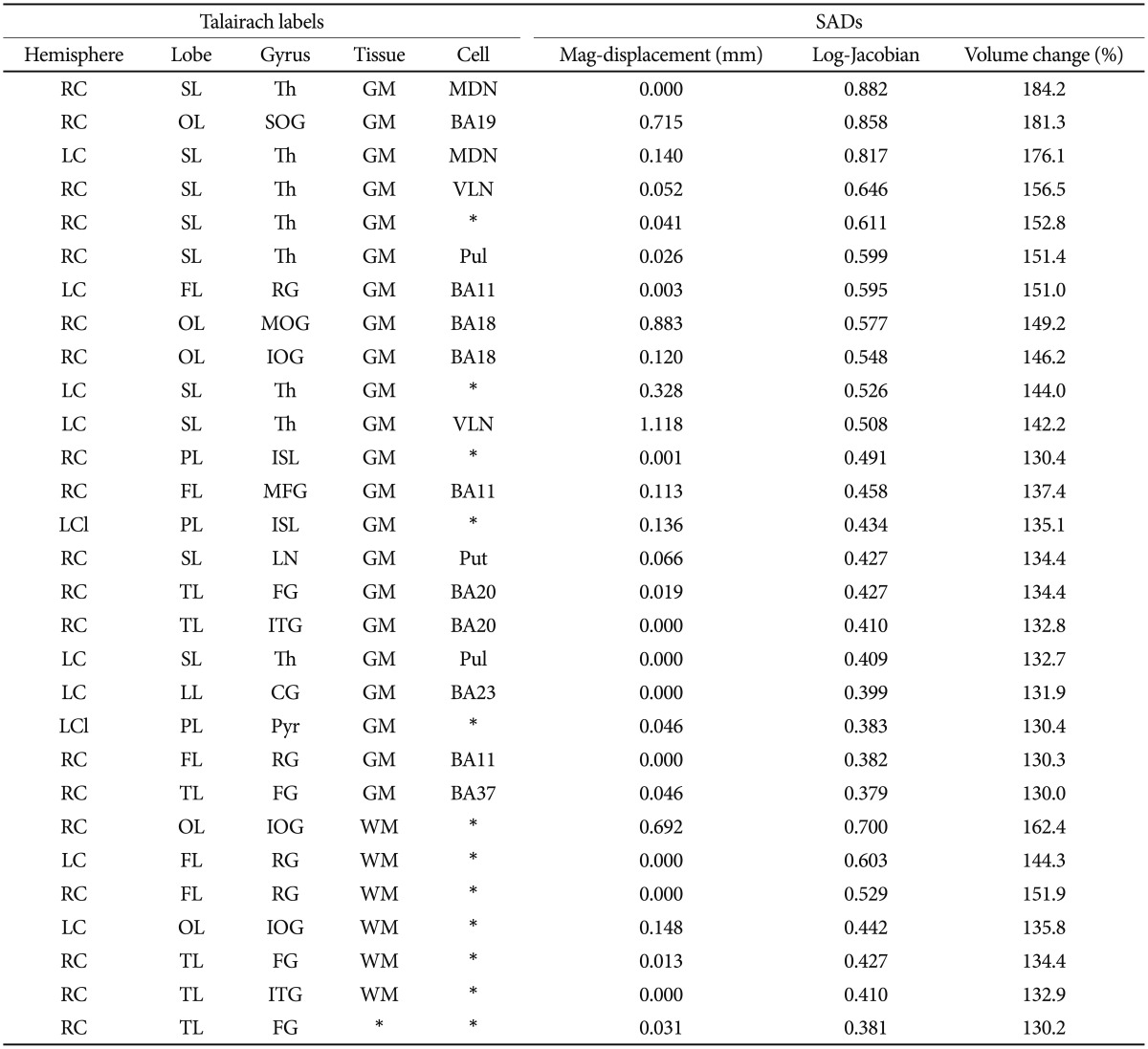1. Giedd JN, Blumenthal J, Jeffries NO, Castellanos FX, Liu H, Zijdenbos A, et al. Brain development during childhood and adolescence: a longitudinal MRI study. Nat Neurosci 1999;2:861-863. PMID:
10491603.


2. Ashburner J, Friston KJ. Voxel-based morphometry -- the methods. Neuroimage 2000;11:805-821. PMID:
10860804.


3. Kasai K, Iwanami A, Yamasue H, Kuroki N, Nakagome K, Fukuda M. Neuroanatomy and neurophysiology in schizophrenia. Neurosci Res 2002;43:93-110. PMID:
12067745.


4. Jack CR Jr, Bernstein MA, Fox NC, Thompson P, Alexander G, Harvey D, et al. The Alzheimer's Disease Neuroimaging Initiative (ADNI): MRI methods. J Magn Reson Imaging 2008;27:685-691. PMID:
18302232.



5. Collins DL, Neelin P, Peters TM, Evans AC. Automatic 3D intersubject registration of MR volumetric data in standardized Talairach space. J Comput Assist Tomogr 1994;18:192-205. PMID:
8126267.


6. Ashburner J, Friston KJ. Nonlinear spatial normalization using basis functions. Hum Brain Mapp 1999;7:254-266. PMID:
10408769.



7. Lancaster JL, Fox PT, Downs H, Nickerson DS, Hander TA, El Mallah M, et al. Global spatial normalization of human brain using convex hulls. J Nucl Med 1999;40:942-955. PMID:
10452309.

8. Mazziotta J, Toga A, Evans A, Fox P, Lancaster J, Zilles K, et al. A probabilistic atlas and reference system for the human brain: International Consortium for Brain Mapping (ICBM). Philos Trans R Soc Lond B Biol Sci 2001;356:1293-1322. PMID:
11545704.



9. Toga AW, Thompson PM. Maps of the brain. Anat Rec 2001;256:37-53. PMID:
11323769.

10. Fox PT, Perlmutter JS, Raichle ME. A stereotactic method of anatomical localization for positron emission tomography. J Comput Assist Tomogr 1985;9:141-153. PMID:
3881487.


11. Talairach J, Tournoux P. Co-Planar Stereotaxic Atlas of the Human Brain: 3-D Proportional System - An Approach to Cerebral Imaging. New York: Thieme Medical Publishers; 1988.
12. Chau W, McIntosh AR. The Talairach coordinate of a point in the MNI space: how to interpret it. Neuroimage 2005;25:408-416. PMID:
15784419.


13. Ahsan RL, Allom R, Gousias IS, Habib H, Turkheimer FE, Free S, et al. Volumes, spatial extents and a probabilistic atlas of the human basal ganglia and thalamus. Neuroimage 2007;38:261-270. PMID:
17851093.


14. Shattuck DW, Mirza M, Adisetiyo V, Hojatkashani C, Salamon G, Narr KL, et al. Construction of a 3D probabilistic atlas of human cortical structures. Neuroimage 2008;39:1064-1080. PMID:
18037310.


15. Evans AC, Janke AL, Collins DL, Baillet S. Brain templates and atlases. Neuroimage 2012;62:911-922. PMID:
22248580.


16. Fonov V, Evans AC, Botteron K, Almli CR, McKinstry RC, Collins DL, et al. Unbiased average age-appropriate atlases for pediatric studies. Neuroimage 2011;54:313-327. PMID:
20656036.


20. Jenkinson M, Beckmann CF, Behrens TEJ, Woolrich MW, Smith SM. FSL. Neuroimage 2012;62:782-790. PMID:
21979382.


21. Jackson FL. Race and ethnicity as biological constructs. Ethn Dis 1992;2:120-125. PMID:
1467750.

22. Buckner RL, Head D, Parker J, Fotenos AF, Marcus D, Morris JC, et al. A unified approach for morphometric and functional data analysis in young, old, and demented adults using automated atlas-based head size normalization: reliability and validation against manual measurement of total intracranial volume. Neuroimage 2004;23:724-738. PMID:
15488422.


23. Smith CD, Chebrolu H, Wekstein DR, Schmitt FA, Markesbery WR. Age and gender effects on human brain anatomy: a voxel-based morphometric study in healthy elderly. Neurobiol Aging 2007;28:1075-1087. PMID:
16774798.


24. Moriguchi Y, Ohnishi T, Kawachi T, Mori T, Hirakata M, Yamada M, et al. Specific brain activation in Japanese and Caucasian people to fearful faces. Neuroreport 2005;16:133-136. PMID:
15671862.


25. Altaye M, Holland SK, Wilke M, Gaser C. Infant brain probability templates for MRI segmentation and normalization. Neuroimage 2008;43:721-730. PMID:
18761410.



26. Wilke M, Holland SK, Altaye M, Gaser C. Template-O-Matic: a toolbox for creating customized pediatric templates. Neuroimage 2008;41:903-913. PMID:
18424084.


27. Chee MW, Chen KH, Zheng H, Chan KP, Isaac V, Sim SK, et al. Cognitive function and brain structure correlations in healthy elderly East Asians. Neuroimage 2009;46:257-269. PMID:
19457386.


28. Kochunov P, Fox PC, Lancaster J, Tan LH, Amunts K, Zilles K, et al. Localized morphological brain differences between English-speaking Caucasians and Chinese-speaking Asians: new evidence of anatomical plasticity. Neuroreport 2003;14:961-964. PMID:
12802183.


29. Lee JS, Lee DS, Kim J, Kim YK, Kang E, Kang H, et al. Development of Korean standard brain templates. J Korean Med Sci 2005;20:483-488. PMID:
15953874.



30. Tang Y, Hojatkashani C, Dinov ID, Sun B, Fan L, Lin X, et al. The construction of a Chinese MRI brain atlas: a morphometric comparison study between Chinese and Caucasian cohorts. Neuroimage 2010;51:33-41. PMID:
20152910.



31. Sato K, Taki Y, Fukuda H, Kawashima R. Neuroanatomical database of normal Japanese brains. Neural Netw 2003;16:1301-1310. PMID:
14622886.


32. Uchiyama HT, Seki A, Tanaka D, Koeda T, Jcs group. A study of the standard brain in Japanese children: morphological comparison with the MNI template. Brain Dev 2013;35:228-235. PMID:
22669123.


33. Kim TH, Park JH, Lee JJ, Jhoo JH, Kim BJ, Kim JL, et al. Overview of the Korean Longitudinal Study on Cognitive Aging and Dementia. Alzheimers Dement 2013;9(Suppl 4):626-627.

34. Hughes CP, Berg L, Danziger WL, Coben L. A new clinical scale for the staging of dementia. Br J Psychiatry 1982;140:566-572. PMID:
7104545.


35. American Psychiatric Association. Diagnostic and Statistical Manual of Mental Disorders: DSM-IV. Task Force on DSM-IV. Washington, DC: American Psychiatric Association; 1994.
36. Lee JH, Lee KU, Lee DY, Kim KW, Jhoo JH, Kim JH, et al. Development of the Korean version of the Consortium to Establish a Registry for Alzheimer's Disease Assessment Packet (CERAD-K): Clinical and neuropsychological assessment batteries. J Gerontol B Psychol Sci Soc Sci 2002;57:P47-P53. PMID:
11773223.


37. Oldfield RC. The assessment and analysis of handedness: the Edinburgh inventory. Neuropsychologia 1971;9:97-113. PMID:
5146491.


39. Shattuck DW, Leahy RM. BrainSuite: an automated cortical surface identification tool. Med Image Anal 2002;6:129-142. PMID:
12045000.


40. Ashburner J, Friston KJ. Unified segmentation. Neuroimage 2005;26:839-851. PMID:
15955494.


41. Colliot O, Chételat G, Chupin M, Desgranges B, Magnin B, Benali H, et al. Discrimination between Alzheimer disease, mild cognitive impairment, and normal aging by using automated segmentation of the hippocampus. Radiology 2008;248:194-201. PMID:
18458242.


42. Chen Y, Wolk DA, Reddin JS, Korczykowski M, Martinez PM, Musiek ES, et al. Voxel-level comparison of arterial spin-labeled perfusion MRI and FDG-PET in Alzheimer disease. Neurology 2011;77:1977-1985. PMID:
22094481.



43. Ashburner J. A fast diffeomorphic image registration algorithm. Neuroimage 2007;38:95-113. PMID:
17761438.


44. Zhang Y, Zhang J, Hsu J, Oishi K, Faria AV, Albert M, et al. Evaluation of group-specific, whole-brain atlas generation using Volume-based Template Estimation (VTE): application to normal and Alzheimer's populations. Neuroimage 2014;84:406-419. PMID:
24051356.


46. Zilles K, Kawashima R, Dabringhaus A, Fukuda H, Schormann T. Hemispheric shape of European and Japanese brains: 3-D MRI analysis of intersubject variability, ethnical, and gender differences. Neuroimage 2001;13:262-271. PMID:
11162267.


47. Karas GB, Scheltens P, Rombouts SA, Visser PJ, van Schijndel R, Fox NC, et al. Global and local gray matter loss in mild cognitive impairment and Alzheimer's disease. Neuroimage 2004;23:708-716. PMID:
15488420.


48. Chételat G, Landeau B, Eustache F, Mézenge F, Viader F, de la Sayette V, et al. Using voxelbased morphometry to map the structural changes associated with rapid conversion in MCI: a longitudinal MRI study. Neuroimage 2005;27:934-946. PMID:
15979341.


49. Teipel SJ, Born C, Ewers M, Bokde AL, Reiser MF, Möller HJ, et al. Multivariate deformation-based analysis of brain atrophy to predict Alzheimer's disease in mild cognitive impairment. Neuroimage 2007;38:13-24. PMID:
17827035.


50. de Jong LW, van der Hiele K, Veer IM, Houwing JJ, Westendorp RG, Bollen EL, et al. Strongly reduced volumes of putamen and thalamus in Alzheimer's disease: an MRI study. Brain 2008;131:3277-3285. PMID:
19022861.



51. Cherubini A, Péran P, Spoletini I, Di Paola M, Di Iulio F, Hagberg GE, et al. Combined volumetry and DTI in subcortical structures of mild cognitive impairment and Alzheimer's disease patients. J Alzheimer Dis 2010;19:1273-1282.

52. Roh JH, Qiu A, Seo SW, Soon HW, Kim JH, Kim GH, et al. Volume reduction in subcortical regions according to severity of Alzheimer's disease. J Neurol 2011;258:1013-1020. PMID:
21240517.


53. Newman J. Thalamic contributions to attention and consciousness. Conscious Cogn 1995;4:172-193. PMID:
8521257.


54. Van der Werf YD, Witter MP, Uylings HB, Jolles J. Neuropsychology of infarctions in the thalamus: a review. Neuropsychologia 2000;38:613-627. PMID:
10689038.


 . Furthermore, the Jacobian determinant is an indicator of volumetric change at each voxel under deformation. Its value is >1, 1, or <1 if there is volume expansion, preservation, or contraction, respectively. Therefore, we derived two kinds of maps for each test subject registered to each template: the magnitude of displacement vectors (i.e., mag-displacement) and log of Jacobian determinants (i.e., log-Jacobian).
. Furthermore, the Jacobian determinant is an indicator of volumetric change at each voxel under deformation. Its value is >1, 1, or <1 if there is volume expansion, preservation, or contraction, respectively. Therefore, we derived two kinds of maps for each test subject registered to each template: the magnitude of displacement vectors (i.e., mag-displacement) and log of Jacobian determinants (i.e., log-Jacobian).

















